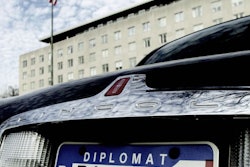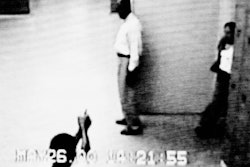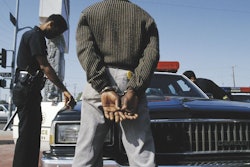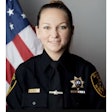It's the middle of the night, and I'm sitting in a marked Decatur (Ill.) Police Department Chevy Tahoe with a big dog-a Belgian Malinois named Rico-and Officer Dan Wise, the third-shift K-9 handler.
"So if I'm hunting a man, I'd set up a perimeter, say two to three blocks around where we think he is," says Wise as he shares with me tactics he uses on the job. "We'll let the suspect know we're out here, have him go to ground, try to wait us out. He'll be scared, and his fear-the adrenaline and sweat-will give the dog something good to work with. Then the dog will work that track right to the suspect, and we'll call him out. If he's dangerous and wanted for a serious crime, then we might let the dog go in and get him..."
Hunting is a consistent theme with the K-9 handlers of Decatur PD's highly regarded K-9 program. All the handlers are hunters, used to working with dogs in the field, hunting both game and men. Macon County (Ga.) Dep. Joe Mannix, who trains with the Decatur program, approves of this arrangement. "Hey, I pay good money to go hunting," he says. "When I come in to work, I get paid to hunt with my dog. Makes you really want to come to work."
Over continual rounds of coffee, Skoal, and Mountain Dew, the handlers share some insights about their jobs.
Dedication Required
First-shift handler Officer Steve Jostes, who is the master trainer for the Decatur unit as well as for a number of neighboring municipalities, says, "It's the best job in the department...for the right officer."
Jostes says the allure of working in the K-9 unit can draw all sorts of officers who want to get into it more for the perks than for the love of the job.
"Some guys think, 'Hey, if I'm a K-9 officer I'll get a take-home car and extra pay, so I think I'll get a dog.' But it's not like that." Especially in a small town where a member of the K-9 unit is a hot commodity that needs to be available when needed, the demands of working with a dog can be stressful.
"This job can have an impact on your long-term career prospects," says Jostes. "There's a lot of stress from the call-outs: wearing a pager and being on call all the time. You need real commitment to this job; you can't go halfway."
Being a K-9 trainer, Jostes knows how much effort goes into maintaining critical skills in addition to the hours logged on duty.
"You've got to spend the time on training," says Jostes. "The dog's performance doesn't lie, and you can't hide it."
Personal attitude and having a family amenable to accommodating a K-9 are also important, according to Jostes. "A good handler's got to have a good temper, good interpersonal skills, and he's got to have a good interface with his family. Having a police dog at home, you've got to think about your kids, your wife, your neighbors, all those things."
Jostes also warns that even if you feel you might be right for the job and are willing to take on the stresses and responsibilities involved, the higher-ups might take issue with a less than stellar track record. "A real big piece is what kind of history you've got as a cop before taking on a dog," he says. "Before you apply, ask yourself, what's your use-of-force background?"
Stumbling Blocks
The Decatur Police Department serves a community of 80,000 with 164 sworn officers and 37 civilian personnel. Among small to mid-size departments, Decatur PD enjoys an excellent reputation in central Illinois for a number of reasons, including its K-9 program.
Deputy Chief Todd Walker, who provides the administration-level guidance for the K-9 program, relates how the K-9 unit recently participated in a multi-agency manhunt scenario training exercise: "Our dogs were so good we offended some people by catching the escapees so quickly."
But that level of performance didn't come easily, and Decatur's journey to excellence started with some rocky low points.
In the late 1970s, the legacy of the civil rights movement and widely circulated pictures of police dogs turning on non-violent protestors led the police administration to mandate there be no police dogs in the Decatur Police Department. There were concerns, both within the department and from the community, that dogs were inappropriate, especially in a town with a history of labor disputes and civil unrest and lingering racial tension.
But in 1982, the police administration decided to revisit the idea of a K-9 unit. A publicity campaign to promote local support was launched. The administration reached out to local community organizations to generate support for the program in the form of favorable opinion and donations of equipment and dogs.
There were some serious stumbling blocks in the first start-up: the dogs donated weren't really appropriate for police work; they weren't bred for it. Without good basic material to start with, the training available didn't adhere as well, with subsequently poor results on the street.
"So we had to go back to square one," says Decatur Police Chief Mark Barthelemy. "We had to get our dogs, training, and equipment up to standard."[PAGEBREAK]
Starting Over
Learning from its mistakes, the department set out to devote enough resources and attention to developing a full-fledged K-9 unit.
"There are four principal steps you have to take to get a good dog program off the ground," Barthelemy can now say from experience.
"First, you have to do your research," he says. "You need to know all the ins and outs of what it takes to make a good dog program. And cost is one of the biggest concerns. You've got to spend money to get a quality program."
Decatur PD has found a variety of ways to pay for its K-9 unit. "Drug seizure money can help and there are other resources you can tap if you know your budget," Barthelemy says. "You reach out to all levels of the department for input as well as other agencies."
Having the resources to start and maintain a unit won't help if the agency and the community it serves aren't supportive, however.
"You have to sell your concept to the community and to the municipality leadership," Barthelemy says. "You have to openly discuss your intentions and the projected capability of the unit. You need the support of the community and the city leadership to make it happen."
Barthelemy says the key to maintaining community support for a K-9 program is keeping the public informed of the continued benefit to citizens.
"You have to manage public perception with a public relations campaign program to sustain support for your program," he says. "Our unit is very visible, involved in over a hundred public education demonstrations a year, conducting searches for missing seniors and children, and so on. Our community has a lot of confidence in our program and supports us because we let them know what we're doing, right up front."
Even after following the first three steps, "You have to educate," says Barthelemy. "You have to educate city administrators. You have to educate the rest of the police department how to utilize the K-9 capability. You need to educate and work with prosecutors so they understand what the dogs can and can't do."
Don't think you're done once you've completed all of these tasks, the chief warns. "All of these things are on-going processes."
Handler Requirements
While Chief Barthelemy sets the direction and steers the department, Dep. Chief Todd Walker runs the agency's patrol division and administers the K-9 program. And while every aspect of the unit is important, the officers working with the dogs every day are integral to the entire system.
"The handler is really key," says Walker. "You have to have very good, very special people in that position. Not just anybody can do it."
Because of the many demands placed on a K-9 handler and the importance of the job to the entire agency, each prospective member of the unit must meet some high expectations just to be considered.
"When we interview for a handler position, we want someone who's been doing an excellent job in patrol for three to five years, with an excellent use-of-force record. I want a handler who'll give me 150 percent every day; who has a positive attitude; has physical stamina; has demonstrated responsibility and excellence in his previous assignments; has the ability to manage his family commitments (and the stability to do so) around the time demands of taking care of a dog and being on call. Those are rigorous criteria."
To determine that each candidate can meet these criteria, every one undergoes a lengthy review process.
"We have them do a written application, which we review for basic qualifications. Then we do an interview, and then we send them out to work with the handlers. We compile our impressions and make a decision. Then they're out of service for training-several months worth-to get them ready for our outside certifications from organizations such as the North American Police Working Dog Association."
But the extra work doesn't end once an officer becomes a handler. In fact, that's just when it begins. "Once they're back in service," Walker says, "the K-9 handlers don't respond to the regular calls for service the other officers do. They're specialized support for the entire shift."[PAGEBREAK]
Money, Money, Money
"One thing I'd really stress to anybody starting up a program is to get a good handle on the actual costs of the program during your start-up research," Walker advises.
The cost of the dog is only the beginning of the cost to run a K-9 unit. Overlooking maintenance costs, especially at a small department, could spell disaster for the unit's budget.
"A quality dog bred for police work costs us between $6,000 and $8000," says Walker. "You need to factor into your annual cost projections the expenses related to consumable equipment like leads, training costs (travel and per diem to national certification events, etc.), food, grooming, boarding, building kennels at the handler's home, medical costs (a big hidden expense), specialty vehicles for the K-9 and handler, and so on."
Of course, everyone has to work together for a K-9 program to work.
"It takes good people, smart budgeting, proper administration, and first-line supervision, which falls to my designated K-9 coordinator, a sergeant. If you do everything right, then you have a valuable department asset in dogs that can do aggression, crowd control, narcotics, article searches, and individual searches-at a very high level of performance."
Supervising Day-to-Day Operation
Decatur PD's designated K-9 coordinator is Sgt. Dave Stewart, who before his promotion and assignment as coordinator was a K-9 handler for 10 years.
As supervisor of the K-9 unit, Stewart is constantly concerned not only with the way his officers and K-9s perform, but with how their efforts are received. Stewart knows that, regardless of the unit's success, if it falls out of favor he and his officers could be out of a job.
He echoes a recurring theme: "Public perception of the dog program doesn't always relate to the actual way the dogs are used, so it's very important to manage your perception. We do that by selecting the right people, and through training."
To maintain a high level of professionalism and effectiveness, training is a top priority.
"The training process starts when the new handler is selected and assigned a dog and continues, non-stop, until that dog retires," says Stewart. "Then the handler either moves on or is assigned a new dog, and the process goes on."
While handlers and K-9s can't literally train constantly, they don't get much of a breather between work and training.
"Our handlers train a minimum eight hours a week on a dedicated training day, where all the handlers get together and run different problems. If things are slow on a shift, sometimes they'll also do training during a shift."
Decatur PD even uses a building dedicated to training that it shares with the agency's Emergency Response Unit. The structure contains several rooms and numerous props, such as suitcases, that help keep the training conducted there realistic.
In addition to training, Stewart, as the K-9 coordinator, manages the unit's overall workings and records keeping.
"In terms of day-to-day management, I organize public appearances and track and compile the reports of K-9 usage for a monthly report to Dep. Chief Walker. I also compile a six-month report and a yearly report. Things we track include training, searches, building searches, tracks, drug seizures, apprehensions, demonstrations, handguns recovered, money seized, vehicles seized, out-of-agency requests, and so on. All that hard data goes up the chain to Dep. Chief Walker for his evaluation of the on-going effectiveness of the program. That information is how we evaluate the performance of the officers and the unit."
Getting the Job Done
There is a common thread evident in all of the K-9 unit administrators' and supervisors' perspectives. All involved want to make sure that there's a clear administration policy and good public perception management. To do this they all agree on the importance of selecting good people, quality dogs and equipment, high-quality initial and ongoing training. Most importantly, they agree that at some point the higher-ups need to get out of the way and let everyone do their own jobs.
"A good handler has to be somebody who doesn't need close supervision," says Officer Steve Jostes, the master trainer. "It's got to be somebody who'll work hard on their own, not a show boater."
I saw evidence of this in the time I spent observing training with Jostes and his handlers. We ran man tracks, did article searches, and a building search with a bite apprehension scenario. The dogs' performances were exceptional. When I was a Federal Air Marshal, I participated in many certification and training exercises for the FAA's Explosive Dog Detection Program, so I'm quite familiar with rating dog performance. The Decatur Department dogs and handlers rate right up at the top.
And that reputation filters down to the street. As one suspect in custody observed, "You don't be running from no Decatur dogs."












